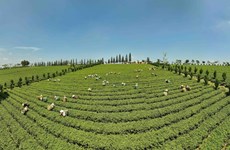Ca Mau province looks to develop vibrant blue economy
Endowed with a 254-km coastline and an abundance of aquatic resources, the southernmost province of Ca Mau has viewed sea-based economic development as an inexorable trend to help it create breakthroughs in socio-economic development.
 Illustrative image (Photo: VNA)
Illustrative image (Photo: VNA)Priority on infrastructure development
Due attention has been given to developing infrastructure in order to develop the blue economy in an effective and sustainable manner that is commensurate with the province’s advantages and potential.
Ca Mau plans to continue calling for investment in infrastructure at the 10,802-ha Nam Can Economic Zone, which is envisaged to become a sea-based economic zone with sound logistics services to meet regional and international distribution demand.
It is also encouraging investment to build Song Doc and Nam Can towns into third-tier urban areas by 2025.
Along with developing fifth-tier urban areas in coastal districts such as Dam Doi, Ngoc Hien, Phu Tan, Tran Van Thoi, and U Minh, the province will invest in engineering and shipbuilding industries at the Song Doc, Khanh Hoi, and Rach Goc estuaries, while carrying out construction of the Tan Thuan, Rach Goc, and Cai Doi Vam industrial clusters.
Socio-economic infrastructure in coastal communes, districts, and islands are being completed, providing the conditions necessary for blue economic development.
The province has given top priority to investment in important economic sectors such as aquaculture, tourism and services, renewable energy, and the maritime economy.
It is also improving local fisheries infrastructure to enhance logistics services, and calling for investment in logistics centres in Hoa Trung, Nam Can, Song Doc, and Hon Khoai.
Comprehensive development of the blue economy promoted
 Harvesting white-leg shrimp in Nam Can district of Ca Mau province (Photo: VNA)
Harvesting white-leg shrimp in Nam Can district of Ca Mau province (Photo: VNA)The province targets catching 800,000 tonnes of fish and seafood by 2030.
Along with developing a strong fishing fleet of more than 4,500 vessels, the province will also re-arrange seafood production based on expanding cooperatives and collectives to benefit fishing families and the sustainable protection of the ecosystem.
Ca Mau will fund the upgrading of infrastructure at fishing ports and storm shelters, as well as complete a fishing vessel information system to give timely warnings to fishermen in case of incidents at sea or to facilitate search and rescue efforts.
It will work to create concentrated aquaculture areas that produce high-quality aquatic species, apply state-of-the-art technologies into production, and develop a traceability system for products.
Relevant authorities will expand monitoring systems in concentrated aquaculture areas, to provide environmental and disease warnings to farmers.
The province will also work to create jobs for 25,000 local people living in coastal resettlement areas./.












